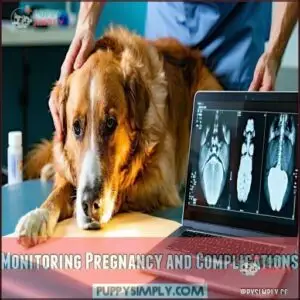This site is supported by our readers. We may earn a commission, at no cost to you, if you purchase through links.
 Dog X-rays typically cost between $75 and $500, with the price varying based on factors like your dog’s size, the area being X-rayed, and the veterinary clinic’s location.
Dog X-rays typically cost between $75 and $500, with the price varying based on factors like your dog’s size, the area being X-rayed, and the veterinary clinic’s location.
If your vet needs to use sedation or anesthesia, especially for larger or anxious dogs, you might see the price go up.
The number of X-rays needed and the complexity of your dog’s condition can also affect the bill.
While it might feel like a big expense, X-rays are a valuable tool for diagnosing issues like broken bones or detecting foreign objects.
And yes, there are ways to save—pet insurance might help.
Table Of Contents
- Key Takeaways
- Factors Affecting Dog X-Ray Costs
- Average Cost of Dog X-Rays
- Reasons for Dog X-Rays
- Benefits of Dog X-Rays
- Limitations of Dog X-Rays
- Additional Imaging Techniques and Costs
- Pet Insurance Coverage for Dog X-Rays
- Preparing for Your Dog’s X-Ray Procedure
- Frequently Asked Questions (FAQs)
- How much do dog X-rays cost?
- What is an X-ray for a dog?
- Why do veterinary X-rays cost so much?
- Where can I get Free X-rays for my Dog?
- How long does it take to get a dog X-rayed?
- Should I get an X-ray for my Dog?
- How much is a typical X-ray for a dog?
- How much do vets charge for dog X-rays?
- How much is a vet visit with an X-ray?
- How much does a dog X-ray cost?
- Conclusion
Key Takeaways
- Dog X-rays typically cost $75 to $500, with most falling between $150 and $250, depending on factors like your dog’s size, sedation needs, and location.
- Sedation, which can add $40 to $200 to the cost, is often required for larger dogs or wiggly pets to ensure clear images.
- Some clinics and regions charge higher, especially in urban areas or emergency situations, so shop around and compare prices.
- Pet insurance can help cover diagnostic costs, but pre-existing conditions are usually excluded, so check coverage details carefully.
Factors Affecting Dog X-Ray Costs
Dog X-ray costs can vary widely based on several factors, like your dog’s size, the injury’s location, and whether sedation is needed.
Dog X-ray costs depend on size, injury location, and whether sedation is required, making planning ahead essential for your pet’s care.
Understanding these details helps you prepare for potential expenses and make informed decisions about your pet’s care.
This allows you to plan and make the best choices for your dog, considering the expenses.
Sedation and Anesthesia
Sedation and anesthesia are key when your dog needs an X-ray, aiding in stillness for clear imaging.
Costs vary from $40 to $200 depending on these factors:
- Dog size, as larger dogs need more medication.
- Procedure complexity, requiring longer sedation.
- Recovery process effects particular to your pet.
- Specific anesthesia types used.
- Alternatives considered for non-invasive cases.
Discuss sedation risks and options with your vet.
Location of Injury or Illness
The cost of a dog X-ray often depends on where the injury or issue is located.
Certain areas, like legs or hips, are simpler to image and typically involve lower costs, such as $100–$425 for dog leg X-rays or $150+ for dog hip X-rays.
However, imaging other regions, like the chest or abdomen, might require advanced techniques. For example, a dog chest X-ray usually costs $150–$250, especially if it’s evaluating organ specifics or a tumor site.
Foreign body detections or dental issues may also influence pricing. Fracture location and complexity play a big role too, as more challenging sites can drive up the overall dog X-ray cost, which can be a significant factor in the overall dog X-ray cost.
Number of X-Rays Needed
The number of X-rays your dog needs depends on the condition’s complexity.
For thorough Severity Assessment and Diagnostic Accuracy, vets often require multiple images from different angles.
Each additional view raises the cost of dog X-rays.
Follow-up Imaging might also be necessary, especially for certain Breed Predispositions, further impacting dog Xray prices.
Discuss options with your vet to manage costs effectively.
Geographic Location and Veterinary Clinic
Where you live can heavily influence veterinary X-ray costs.
Urban locations usually charge more than rural areas, and clinic size or reputation matters too. Don’t forget, emergency visits and specialized vets also raise fees.
- Urban vs Rural: City clinics have higher rates.
- Regional Pricing: Costs vary by area.
- Specialist Availability: Specialists cost more.
- Cost Variation: Shop around for better deals.
For adult dogs, annual checkups are important, but senior dogs need more frequent monitoring.
Size and Breed of Dog
Your dog’s size and breed substantially impact x-ray costs, as larger dogs can present unique challenges.
Bigger pups often require more sedation, specialized handling, and additional imaging adjustments, which naturally increase expenses. Small breeds, while easier to position, may still need delicate techniques for accuracy.
Certain breeds also have health predispositions, influencing imaging needs and the cost of dog xrays.
- Size Matters: Larger dogs often lead to higher sedation needs.
- Breed Predisposition: Some breeds require specialized imaging.
- Sedation Needs: Bigger dogs need more sedation.
- Cost Variation: Size and breed influence pricing unpredictably.
Average Cost of Dog X-Rays
Dog X-rays typically cost between $75 and $500, with $150 to $250 being the average dog xray cost.
Geographic location and clinic type play a big role in cost variations. For example, veterinary xray costs in urban areas tend to be higher.
Here’s a breakdown:
| Type of X-Ray | Cost Range |
|---|---|
| Standard X-Ray | $75 – $500 |
| Sedation (if needed) | $40 – $200 |
| Emergency Fee | Higher |
Planning ahead helps manage pet xray cost surprises! If soft tissue issues are suspected, consider that dog MRI costs can be substantially higher.
Reasons for Dog X-Rays
You might need an X-ray for your dog if they’ve suffered an injury, swallowed something harmful, or shown unexplained health issues.
This quick, painless procedure helps your vet diagnose problems like broken bones, tumors, or internal blockages with accuracy.
Diagnosing Broken Bones and Orthopedic Issues
When your pup takes a tumble, X-rays help pinpoint issues like fractures or hip dysplasia. They reveal the severity of broken bones and detect arthritis or bone infections.
For orthopedic concerns, trust X-rays for clear answers. Common issues like lameness can also be identified through X-rays, but it’s important to also consider other orthopedic issues.
- Fracture severity and location assessments
- Hip dysplasia monitoring
- Dog leg X-ray costs for injuries
- Spinal injuries and arthritis diagnosis
Detecting Foreign Objects and Stones
Sometimes, curiosity lands pets in trouble.
Curiosity can lead pets into sticky situations, but quick vet care ensures they bounce back stronger than ever.
If an ingested object causes a blockage, an xray for dogs can quickly reveal the culprit. Foreign objects, from swallowed toys to odd snacks, show up clearly on radiographs.
Detecting bladder stones depends on stone composition and object size, helping vets decide if surgery is necessary.
Costs depend on blockage severity and the type of pet xray required. Prevent issues with dietary changes and regular vet visits—it’s cheaper than surprise foreign object removal, which can be a surprise!
Identifying Tumors and Cancer
In the context of tumors, early detection saves lives.
X-rays play a pivotal role in veterinary diagnosis, revealing bone tumors and assisting with cancer staging. They’re often the first step in planning treatment.
- Key benefits: Improved accuracy in tumor detection.
- Limitations: Some tumors require advanced imaging.
- Consider costs: A canine xray price varies, starting at $75.
Monitoring Pregnancy and Complications
Gestation X-rays are invaluable for monitoring your pregnant dog’s health.
They help confirm puppy count, check fetal viability, and reduce risks like dystocia (difficult birth).
Knowing the puppies’ sizes and positions can prevent pregnancy complications and even avoid emergency situations.
Veterinary imaging, such as X-rays or ultrasound, gives peace of mind by confirming everything’s on track before delivery.
While dog xray costs vary, this investment in your pet’s health guarantees preparedness and safety for both mom and her pups, ensuring a successful outcome with proper care.
Benefits of Dog X-Rays
Dog X-rays give you a clear view of what’s happening inside your pet, from bones to internal organs.
They’re quick, painless, and help your vet make accurate diagnoses to guide the best treatment.
Clear Images of Internal Organs and Bones
Dog X-rays offer unmatched image clarity to visualize bones, organs, and tissues with precision.
You’ll gain valuable insights into your pet’s health through diagnostic imaging. Here’s why they’re worth it:
- Bone visibility guarantees fractures or injuries are spotted.
- Organ detail aids in identifying abnormalities.
- X-ray uses include detecting blockages or masses.
- Diagnostic accuracy supports effective treatment plans.
Quick and Painless Procedure
Getting an X-ray for your dog is a quick, stress-free process.
With sedation alternatives, your pup stays relaxed, while minimal radiation guarantees safety. The procedure duration is short, letting you focus on your pet’s care.
Check out this helpful overview:
| Procedure Element | Benefit | Notes |
|---|---|---|
| Sedation Use | Keeps dogs calm | Optional if needed |
| Radiation Level | Very low | Safe for all breeds |
| Time Required | Typically under 30 min | Varies by complexity |
| Dog Comfort | High | Owner presence helps |
| Affordability | Accessible prices | X-ray cost for pets ranges broadly |
Accurate Diagnoses and Treatment
X-rays are essential diagnostic tools, offering clear images to pinpoint health issues like kidney stones or blocked intestines.
Accurate diagnoses drive effective treatment plans, improving health outcomes for your dog while potentially lowering long-term pet diagnostic costs.
Veterinary radiology helps specialists tailor care, ensuring timely disease management, and with insurance, dog X-ray costs or dog radiology costs become more manageable, providing peace of mind for your pet’s health.
Regular veterinary checkups are essential for maintaining a dog’s overall health and detecting potential issues early on, which is crucial for effective treatment plans and timely disease management, ultimately leading to better health outcomes.
Limitations of Dog X-Rays
While dog X-rays are helpful, they don’t always provide the full picture for diagnosing complex issues.
In some cases, advanced imaging like CT scans or MRIs may be necessary to gain more detailed insights.
Diagnostic Limitations and Alternative Imaging
X-rays are great for bones but fall short with tissues or dynamic views.
For example, they can’t provide live visuals to detect subtle heart issues or gallbladder stones. This is where ultrasounds, or other pet X-ray alternatives, shine by offering real-time imaging.
Similarly, deeper diagnostic procedures may require advanced imaging innovations, like better detail from CT scans or MRIs.
Despite the x-ray benefits of cost and speed, their diagnostic errors and limited image quality make them insufficient in some cases.
Considering radiation risks, you might explore better solutions while balancing veterinary diagnostic costs for your pet’s care.
High-Cost Alternatives Like CT Scans and MRIs
Sometimes, an X-ray just isn’t enough to uncover what’s going on beneath the surface.
That’s where advanced imaging technology like CT scans and MRIs comes into play. These tools provide unparalleled diagnostic accuracy, especially for soft tissue, brain, or spinal issues that regular X-rays can’t fully reveal.
CT scan costs typically range from $500 to $1,200, making them a more affordable option compared to MRIs, which cost between $1,100 and $1,500.
While CT scans excel at imaging bones and masses, MRI benefits include detailed views of soft tissues, ideal for identifying neurological or muscular problems.
Since these procedures aren’t cheap, adding pet insurance can help ease veterinary diagnostic costs, giving your dog the care they need.
Additional Imaging Techniques and Costs
If your dog needs more than a standard X-ray, advanced imaging techniques like ultrasounds, CT scans, or MRIs may be recommended.
These options come with higher price tags but can provide detailed insights into complex health issues.
Ultrasound Costs and Procedures
Ultrasound is a versatile imaging tool that goes beyond X-rays, capturing real-time views of your dog’s organs.
It’s often used to investigate heart issues or abdominal conditions.
With fees ranging from $300 to $600, ultrasound costs depend on scan techniques and diagnostic uses.
This safe, painless procedure guarantees high image quality with minimal risk.
Ask your vet about pet ultrasound options if additional clarity is required beyond standard dog X-ray costs, for additional clarity.
CT Scan Costs and Procedures
CT scans provide detailed 3D imaging, making them ideal for detecting head injuries or nasal issues.
These scans typically cost $500 to $1,200.
Here’s what to expect:
- Preparation: Your vet may sedate your dog to minimize movement for accurate results.
- Safety: CT scans use minimal radiation and are generally safe.
- Procedure: Scans are painless and quick.
- Results: A radiologist interprets the images to guide effective treatment.
CTA: Consult your vet on CT scan suitability.
MRI Costs and Procedures
An MRI might sound complex, but it’s essential for pinpointing brain and spine issues.
Costs range from $1,100 to $1,500, with sedation adding $60–$100 per half hour.
Using advanced MRI machines, these scans provide detailed image analysis for accurate diagnostics.
While pricey compared to basic dog xray costs, MRI scans are worth it for serious issues. Discuss alternatives like CT scans with your vet.
Pet Insurance Coverage for Dog X-Rays
If your dog needs an X-ray, pet insurance can help manage the costs. Understanding your policy’s coverage, exclusions, and claim process is key to avoiding unexpected expenses.
Types of Insurance and Coverage Options
When considering pet insurance for X-rays, focus on coverage plans, reimbursement rates, and deductibles.
Most pet insurance providers cover diagnostic tests like X-rays for accidents or illnesses.
Compare policy options, including accident-only plans or thorough coverage, to fit your budget.
Check how the claim process works too, as it directly impacts out-of-pocket costs.
- Protects against unexpected expenses
- Covers accidents and illnesses
- Offers flexible policy options
- Reduces financial stress
- Simplifies costly treatment decisions
Pre-Existing Conditions and Exclusions
Pre-existing conditions are the “fine print” surprise of pet insurance.
These are health problems your dog had before enrollment, often excluded from coverage.
Chronic illnesses, hereditary issues, or past injuries might fall into this category, leaving you responsible for veterinary diagnostics costs like X-rays.
Here’s a quick breakdown to help:
| Term | Definition | Coverage | Risk Level | Action Needed |
|---|---|---|---|---|
| Pre-existing | Condition pre-policy | Usually excluded | High | Review exclusions |
| Chronic Illness | Ongoing medical issue | Maybe excluded | High | Check policy terms |
| Medical Exclusions | Non-covered conditions | Not covered | Moderate to High | Consider alternatives |
| Insurance Limits | Policy’s max reimbursement | Varies by plan | Medium | Understand limits |
| Health Risks | Certain breeds’ predispositions | May affect coverage eligibility | Low to Medium | Plan accordingly |
Reading and fully understanding pet insurance exclusions guarantees better planning for your dog X-ray costs, ensuring you are prepared for chronic illnesses and medical exclusions, and can make informed decisions about insurance limits and health risks.
Reimbursement and Claim Processes
Understanding the pet insurance claims process can save you stress and time when handling veterinary expenses like X-rays.
To get reimbursed, submit clear documentation through online claim forms—most insurers make it quick and hassle-free.
Here’s how to streamline your pet reimbursement:
- Gather itemized vet bills, proof of payment, and X-ray reports.
- Verify your policy covers the condition (pre-existing issues often aren’t).
- File your claim through mobile apps or websites for faster processing.
- Track claim status to know when to expect payment.
A little preparation simplifies getting your well-deserved refund.
Preparing for Your Dog’s X-Ray Procedure
Getting your dog ready for an X-ray is simple when you know what to expect.
By following your vet’s instructions and preparing your pet ahead of time, you can guarantee everything goes smoothly.
Pre-Procedure Instructions and Preparation
Before heading to your vet, review preparation tips for smooth X-rays.
Confirm fasting instructions, as many pets require fasting to prevent sedation risks. Share your dog’s medical history so the vet can adjust medications if needed.
Don’t shy away from questions–clear communication guarantees you’re on the same page about procedures and xray costs for pets. A calm dog helps keep sedation for xrays minimal, saving on veterinary radiology prices while ensuring your furry friend stays comfortable.
Proper pet xray prep is vital for accurate results and safety, which involves understanding the necessary steps and products for a successful procedure, including those related to pet xray supplies.
What to Expect During The Procedure
During an X-ray procedure, your dog will often be calmed by sedation methods to stay still.
Here’s how it unfolds:
- Prep: Vet staff position your pet for imaging.
- Imaging Process: Quick snapshots are taken.
- Radiation Safety: Minimal exposure guarantees safety.
- Procedure Timing: It’s typically brief.
- Recovery: A short rest follows before vet discussions.
Understanding the X Ray Procedure is vital for pet owners.
Post-Procedure Care and Follow-Up
After an X-ray, help your dog recover smoothly with simple steps:
- Rest: Provide plenty of quiet downtime for recovery.
- Medication management: Follow your vet’s advice for pain relief.
- Home monitoring: Watch for unusual behavior or signs of discomfort.
- Follow-up care: Stick to vet-recommended appointments to track healing.
Proactive care reduces pet medical expenses and guarantees quicker wound healing.
Using a pet recovery kit can be beneficial in the recovery process.
Frequently Asked Questions (FAQs)
How much do dog X-rays cost?
Dog X-rays typically cost $75 to $500, with an average of $150–$
Factors like your dog’s size, the body area scanned, sedation needs, and your location can substantially affect pricing at different clinics.
What is an X-ray for a dog?
An X-ray for a dog is a quick, non-invasive way to capture internal images, helping vets diagnose issues like fractures, organ problems, or foreign objects.
It’s essential for accurate treatment and your dog’s health.
Why do veterinary X-rays cost so much?
Veterinary X-rays cost more due to specialized equipment, trained technicians, and sedation for wiggly or anxious pets.
Add factors like location, emergency care, or complex issues, and you’ve got a recipe for higher prices.
Where can I get Free X-rays for my Dog?
Around 67% of pet owners worry about costs.
But some animal shelters or veterinary schools offer free or low-cost dog X-rays.
Contact local rescue organizations or humane societies—they often know about affordable options nearby.
How long does it take to get a dog X-rayed?
An X-ray for your dog usually takes 10 to 30 minutes, depending on the number of images needed and if sedation is required.
Sedation might add a bit more time for safety and accuracy.
Should I get an X-ray for my Dog?
When in doubt, check it out.
If your dog’s limping, injured, or showing unusual symptoms, an X-ray can pinpoint hidden issues.
It’s a quick, painless way to guarantee your furry friend gets the right care.
How much is a typical X-ray for a dog?
Typical X-rays for dogs cost $75 to $500, averaging $150 to $
Prices depend on factors like your dog’s size, sedation needs, and location.
Emergency clinics often charge double compared to regular veterinary offices, which can significantly impact the total cost.
How much do vets charge for dog X-rays?
Getting an X-ray for your dog is like uncovering clues in a mystery—costs vary.
Expect $75-$500, with most paying $150-$
Factors include size, sedation needs, and location.
Emergency visits often cost more.
How much is a vet visit with an X-ray?
A vet visit with an X-ray usually costs $150 to $500, including consultation fees.
Costs vary depending on the dog’s size, body part imaged, and clinic location.
Emergency visits or sedation may add extra charges.
How much does a dog X-ray cost?
Think of it as tuning up your car—dog X-rays usually run $75-$
Factors like your dog’s size, sedation needs, and the clinic’s location play a big role.
On average, expect $150-$250 per image.
Conclusion
Picture your dog resting on an exam table, ready for an X-ray that could reveal critical answers.
Knowing how much dog X-rays cost—anywhere from $75 to $500—helps you plan for their care. Factors like sedation, your dog’s size, and the clinic’s location influence the price.
While costs can add up, these images play a pivotal role in diagnosing conditions like fractures or tumors.
Consider pet insurance to save. Your dog’s health is always worth the investment.
- https://www.mayoclinic.org/tests-procedures/ultrasound/about/pac-20395177
- https://www.doghealth.com/health/testing/2487-x-rays-in-dogs-what-can-they-tell-your-vet
- https://www.cancer.org/treatment/understanding-your-diagnosis/tests/understanding-radiation-risk-from-imaging-tests.html
- http://www.pethealthnetwork.com/dog-health/my-dogs-veterinarian/medical-imaging-and-your-pet



















